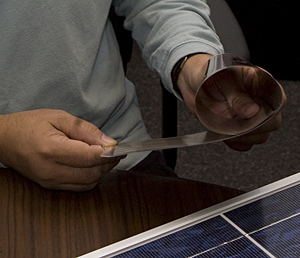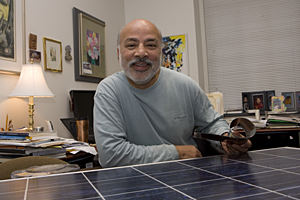
ADVERTISEMENT
- Rozovsky wins prestigious NSF Early Career Award
- UD students meet alumni, experience 'closing bell' at NYSE
- Newark Police seek assistance in identifying suspects in robbery
- Rivlin says bipartisan budget action, stronger budget rules key to reversing debt
- Stink bugs shouldn't pose problem until late summer
- Gao to honor Placido Domingo in Washington performance
- Adopt-A-Highway project keeps Lewes road clean
- WVUD's Radiothon fundraiser runs April 1-10
- W.D. Snodgrass Symposium to honor Pulitzer winner
- New guide helps cancer patients manage symptoms
- UD in the News, March 25, 2011
- For the Record, March 25, 2011
- Public opinion expert discusses world views of U.S. in Global Agenda series
- Congressional delegation, dean laud Center for Community Research and Service program
- Center for Political Communication sets symposium on politics, entertainment
- Students work to raise funds, awareness of domestic violence
- Equestrian team wins regional championship in Western riding
- Markell, Harker stress importance of agriculture to Delaware's economy
- Carol A. Ammon MBA Case Competition winners announced
- Prof presents blood-clotting studies at Gordon Research Conference
- Sexual Assault Awareness Month events, programs announced
- Stay connected with Sea Grant, CEOE e-newsletter
- A message to UD regarding the tragedy in Japan
- More News >>
- March 31-May 14: REP stages Neil Simon's 'The Good Doctor'
- April 2: Newark plans annual 'wine and dine'
- April 5: Expert perspective on U.S. health care
- April 5: Comedian Ace Guillen to visit Scrounge
- April 6, May 4: School of Nursing sponsors research lecture series
- April 6-May 4: Confucius Institute presents Chinese Film Series on Wednesdays
- April 6: IPCC's Pachauri to discuss sustainable development in DENIN Dialogue Series
- April 7: 'WVUDstock' radiothon concert announced
- April 8: English Language Institute presents 'Arts in Translation'
- April 9: Green and Healthy Living Expo planned at The Bob
- April 9: Center for Political Communication to host Onion editor
- April 10: Alumni Easter Egg-stravaganza planned
- April 11: CDS session to focus on visual assistive technologies
- April 12: T.J. Stiles to speak at UDLA annual dinner
- April 15, 16: Annual UD push lawnmower tune-up scheduled
- April 15, 16: Master Players series presents iMusic 4, China Magpie
- April 15, 16: Delaware Symphony, UD chorus to perform Mahler work
- April 18: Former NFL Coach Bill Cowher featured in UD Speaks
- April 21-24: Sesame Street Live brings Elmo and friends to The Bob
- April 30: Save the date for Ag Day 2011 at UD
- April 30: Symposium to consider 'Frontiers at the Chemistry-Biology Interface'
- April 30-May 1: Relay for Life set at Delaware Field House
- May 4: Delaware Membrane Protein Symposium announced
- May 5: Northwestern University's Leon Keer to deliver Kerr lecture
- May 7: Women's volleyball team to host second annual Spring Fling
- Through May 3: SPPA announces speakers for 10th annual lecture series
- Through May 4: Global Agenda sees U.S. through others' eyes; World Bank president to speak
- Through May 4: 'Research on Race, Ethnicity, Culture' topic of series
- Through May 9: Black American Studies announces lecture series
- Through May 11: 'Challenges in Jewish Culture' lecture series announced
- Through May 11: Area Studies research featured in speaker series
- Through June 5: 'Andy Warhol: Behind the Camera' on view in Old College Gallery
- Through July 15: 'Bodyscapes' on view at Mechanical Hall Gallery
- More What's Happening >>
- UD calendar >>
- Middle States evaluation team on campus April 5
- Phipps named HR Liaison of the Quarter
- Senior wins iPad for participating in assessment study
- April 19: Procurement Services schedules information sessions
- UD Bookstore announces spring break hours
- HealthyU Wellness Program encourages employees to 'Step into Spring'
- April 8-29: Faculty roundtable series considers student engagement
- GRE is changing; learn more at April 15 info session
- April 30: UD Evening with Blue Rocks set for employees
- Morris Library to be open 24/7 during final exams
- More Campus FYI >>
10:37 a.m., Oct. 15, 2010----S. Ismat Shah, a University of Delaware professor with joint appointments in the Department of Materials Science and Engineering and the Department of Physics and Astronomy, is helping researchers in Pakistan study solar energy as an alternative to fossil fuels.
Pakistan currently depends on fossil fuels for more than 80 percent of its energy requirements. Solar power, particularly photovoltaics, is considered an untapped resource due to the country's geographical location in a region that receives abundant sunshine throughout much of the year.
“The great thing about solar cell technology is that it brings electricity without wires. You take a panel, put it up on your hut or shanty and you've got power,” says Shah. He estimates that 40 to 45 percent of villages in Pakistan do not have electricity.
Inter-university collaboration
Photovoltaics, also known as solar cell technology, is the process of generating electricity from light.
Shah's work is funded through a $216,000 grant from the U.S. Department of State under Phase 4 of the Pakistan-U.S. Science and Technology Cooperation Program. The program aims to increase cooperation in science, technology, engineering and education between the two countries.
Shah is collaborating with Salamat Ali of Government College University (GCU) in Lahore, Pakistan, to establish a research laboratory at GCU and to train Pakistani researchers in creating, testing and studying organic polymer-based photovoltaics (OPV) as a means to address the country's critical energy needs in a sustainable manner. To date, Pakistani research in photovoltaics is almost nonexistent.
“There are very good scientists in Pakistan; what they lack is resources,” says Shah, whose proposal was one of only 28 selected from among 270 applicants to receive funding. Ali will receive separate funding from Pakistan's Higher Education Commission (HEC).
Versatile applications
Polymer-based photovoltaics are flexible and can literally be painted on almost any surface, eliminating the need for sophisticated equipment. In Pakistan, this will enable even those living in remote villages to harness the sun's energy to create electricity where infrastructure hasn't yet reached. This is similar, says Shah, to the off-grid-electrification technology currently used to pump water to secluded villages in Africa by UD's Engineers Without Borders program.
In the U.S., they can also be used for many purposes. For example, the solar cells could be painted onto a woman's purse, allowing her to charge her cell phone on the way to work, or they could be placed on a farmer's irrigation system so that crops can be watered without using electricity.
Although cheaper than their inorganic silicon counterparts, polymer photovoltaics have had limited success so far. The three-year project will address the three major issues affecting polymer solar cell technology -- efficiency, transport and lifetime. If successful, these nontraditional approaches could potentially reduce barriers to efficient large-scale production of organic photovoltaics in Pakistan.
Under the grant, Shah will teach courses in solar cell technology and thin-film technology at GCU to draw beginning Pakistani researchers into this effort. In addition, undergraduate and graduate students on both sides will visit each other's universities to learn from one another and share findings. Shah said he hopes that by working together on a project of shared scientific interest, participants will forge both personal and professional ties.
“One of my personal goals for the project is the development of a mutual respect between the scientists and students, both in Pakistan and here in the United States,” added Shah, who is originally from Pakistan. “This grant opens the possibility of taking all of my current students to Pakistan to witness the achievements of scientists there, scientists who do wonderful things with very few resources.”
A list of all projects selected in this phase of the program is available at a special program website.
Article by Karen B. Roberts
Photos by Ambre Alexander



